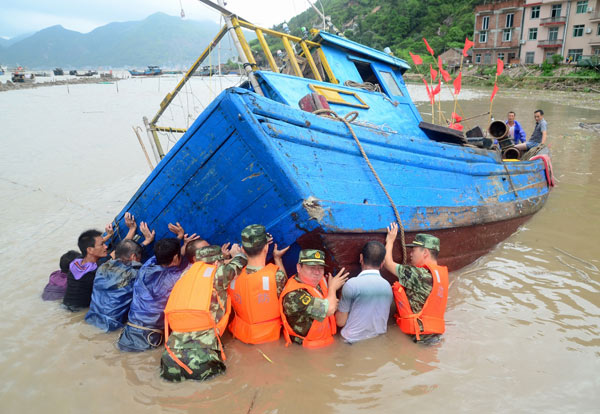

Troops and fishermen try to move a boat to a safer spot in Xiapu, Fujian province, on Thursday, after it was overturned by the powerful winds of Typhoon Trami. Yuan Ziyou for China Daily
Typhoon Trami has slammed into southern China, bringing with it torrential rain, while the country's northeast is tackling severe flooding that has left hundreds of people dead or missing.
Trami, the 12th typhoon to hit the mainland this year, made landfall in the coastal areas of Fuqing, Fujian province, at 2:40 am on Thursday, packing winds of up to 126 km per hour at its center, according to the Fujian Meteorological Center.
Torrential downpours struck the cities of Fuzhou, Ningde, Putian and Sanming on Thursday morning, and 191 counties and towns in the province had received more than 100 mm of rain as of 7 am, the center said.
As it moves west into Jiangxi province, Trami will weaken into a tropical storm or a tropical depression, according to the National Meteorological Center.
The Fujian Meteorological Center cautioned against possible street flooding in urban areas and mudslides in mountainous regions caused by the lingering heavy downpours.
Chen Yanqing, a resident of Changle, said the storm is bigger than Soulik, the typhoon that hit the province last month.
"Strong winds blew off clay roof tiles of my house, and the rain poured into the kitchen. I could not sleep well all night," Chen said.
Lin Xinping, an official with Pingtan county government, said the strong winds toppled trees and knocked over billboards, blocking streets and creating traffic jams on Thursday morning.
The Fujian Provincial Department of Ocean and Fisheries said on Thursday that as of 6 pm Wednesday, 37,157 fishing boats had returned to port and 152,200 people had been relocated as the typhoon approached.
According to the Fujian Provincial Flood Control and Drought Relief Headquarters, as of 11 pm Wednesday, 189,800 residents living in work sheds or dilapidated houses in low-lying areas had moved to safer places.
Traffic was seriously affected, as 64 flights to and from the Fuzhou airport had been canceled since Wednesday. In addition, the intercity high-speed train service between Fuzhou and Xiamen, and between Longyan and Xiamen was halted on Thursday and will remain suspended on Friday.
The Shanghai Railway Station declared on Wednesday night that 15 trains departing for coastal cities such as Xiamen; Fuzhou, Fujian province; and Wenzhou, Zhejiang province, have been halted.
The Shanghai Railway Administration on Thursday temporarily halted 28 high-speed trains that pass through Fuzhou and Xiamen.
Trami was the second typhoon to hit South China this month.
Last week, Typhoon Utor tore through China's southern regions, leaving 70 people dead and another 18 missing, the Ministry of Civil Affairs said on Thursday.
According to the ministry, Guangdong province had the most typhoon-related casualties, with 43 reported deaths as of 9 am Thursday. The storms have affected more than 8 million people and caused direct economic losses of more than 13 billion yuan ($2.12 billion) in Guangdong.
While South China is battling the storms, northeastern China is fighting its worst floods in the past five decades, with more torrential rains expected next week, according to the National Meteorological Center.
The center said that from Sunday to Thursday, heavy rains are expected in Liaoning, Jilin and Sichuan provinces and the Inner Mongolia autonomous region. The center told residents to be on the alert and urged local authorities to reinforce river embankments.
The latest statistics released by the Ministry of Civil Affairs showed that as of Tuesday, floods have caused crop failures across 853,200 hectares of farmland in Liaoning, Jilin and Heilongjiang provinces.
The number of casualties rose to 63 on Wednesday in Liaoning with another 101 still missing, the government said.
The State Flood Control and Drought Relief Headquarters said the central government has allocated about 2.3 billion yuan ($376 million) to flood-hit regions so far.
Copyright ©1999-2018
Chinanews.com. All rights reserved.
Reproduction in whole or in part without permission is prohibited.